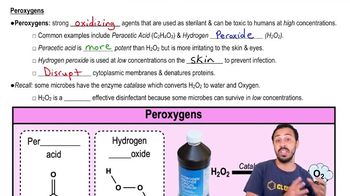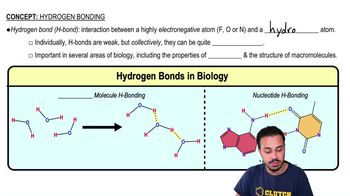Why must NADH be reoxidized? How does this happen in an organism that uses respiration? Fermentation?
Define and explain the importance of each of the following:
a. catalase
b. hydrogen peroxide
c. peroxidase
d. superoxide radical
e. superoxide dismutase
 Verified step by step guidance
Verified step by step guidance
Verified Solution
Key Concepts
Catalase

Hydrogen Peroxide

Superoxide Dismutase

Use the following choices to answer questions 7–10.
a. E. coli growing in glucose broth at 35℃ with O₂ for 5 days
b. E. coli growing in glucose broth at 35℃ without O₂ for 5 days
c. both a and b
d. neither a nor b
Which culture uses NAD⁺ ?
An organism that has peroxidase and superoxide dismutase but lacks catalase is most likely an
a. aerobe.
b. aerotolerant anaerobe.
c. obligate anaerobe.
Feedback inhibition differs from repression because feedback inhibition
a. is less precise.
b. is slower acting.
c. stops the action of preexisting enzymes.
d. stops the synthesis of new enzymes.
e. all of the above
Suppose you inoculate three flasks of minimal salts broth with E. coli. Flask A contains
glucose. Flask B contains glucose and lactose. Flask C contains lactose. After a few hours of incubation, you test the flasks for the presence of ß-galactosidase. Which flask(s) do you predict will have this enzyme?
a. A
b. B
c. C
d. A and B
e. B and C
NAME IT Use the key in the Clinical Focus box to identify the gram-negative, oxidase-positive rod causing pneumonia in a sea otter. It is H₂S-positive, indole-negative, and urease-positive.
